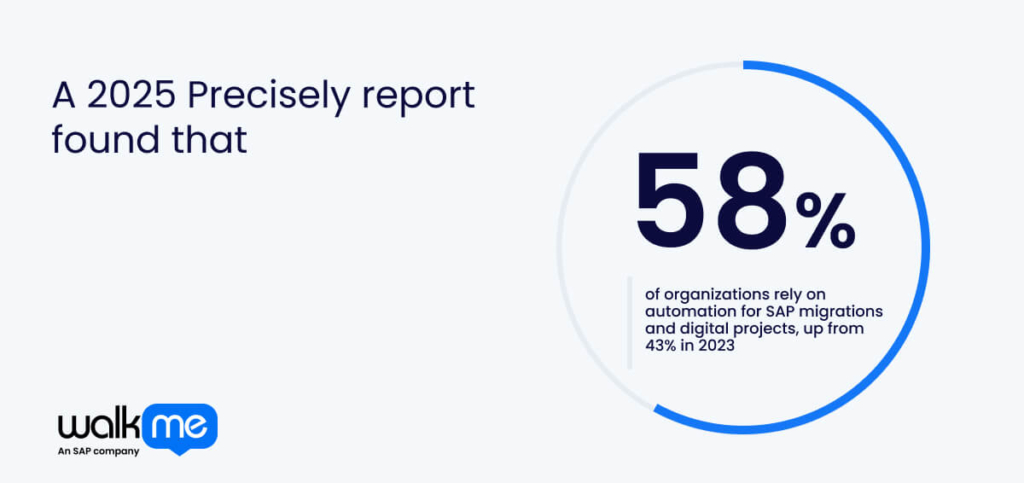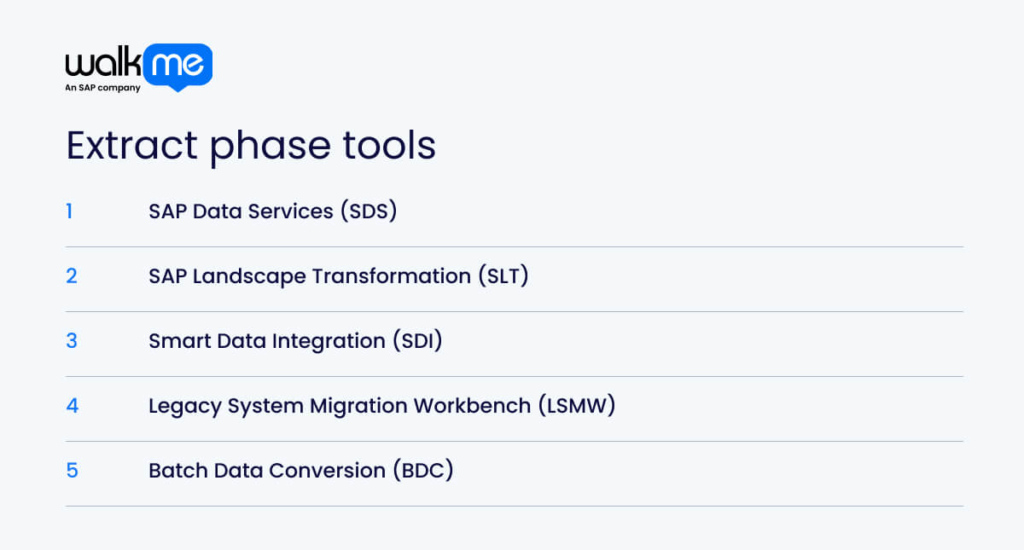SAP data migration tools guide the careful transfer of information into modern SAP systems.
A 2025 Precisely report found that 58% of organizations rely on automation for SAP migrations and digital projects, up from 43% in 2023.

Growing tool adoption reflects demand for speed, accuracy, and ease in moving data across complex landscapes.
Migrating data is crucial for maintaining clean financials, ensuring accurate supply chains, and providing trusted analytics. SAP data migration tools handle extraction, cleansing, transformation, and validation at scale. They support transitions like S/4HANA migration, master data restructuring, and cloud adoption.
Smart data migration also builds confidence in future SAP-based projects. Choosing the right tool turns a risky data transfer into a basis for digital innovation.
This article examines thirteen essential SAP data migration tools across the extraction, transformation, loading, and validation phases, highlighting how each supports seamless, accurate, and efficient SAP transitions.
What are SAP data migration tools?
SAP data migration tools help businesses move data safely into SAP systems. They handle tasks such as extracting data from legacy systems, correcting errors, converting formats, and verifying accuracy. These tools reduce mistakes that occur with manual actions, protecting operations and ensuring compliance.
Take SAP’s Migration Cockpit, for example. It helps companies upgrade to SAP S/4HANA and automate many migration steps. According to a 2024 ASUG report, nearly half of SAP users are already live on S/4HANA or in the process of migrating to it.
With migration risks stabilizing, more organizations are adopting IT process automation to manage complexity and reduce errors during data migration.
This highlights how automation is becoming increasingly essential for smoother and faster SAP transitions. It also ensures data integrity, accelerates the migration process, and allows organizations to focus on leveraging new SAP capabilities rather than addressing data-related issues.
Extract phase tools

Our first housing category is extract phase tools. These tools focus on pulling data from source systems, handling large volumes, and ensuring data accuracy.
Best suited for complex SAP migrations, they work well with various legacy and third-party systems to prepare for data transformation and loading.
Let’s take a look at the best extract phase tools for SAP data migration:
1. SAP Data Services (SDS)
SAP Data Services (SDS) is a robust tool designed to extract, transform, and load data for SAP migrations. It handles large datasets from various sources, ensuring data quality and consistency across all datasets. SDS can also clean, validate, and enrich data before moving it to SAP S/4HANA or other systems.
It supports complex data workflows and offers strong integration with SAP and non-SAP platforms. Companies use SDS to reduce migration risks and speed up projects. Its user-friendly interface lets teams automate data extraction with little effort, making it ideal for large-scale enterprise migrations.
2. SAP Landscape Transformation (SLT)
SAP Landscape Transformation (SLT) is focused on real-time data replication during migrations. It extracts data from source systems and transfers it instantly to SAP HANA or SAP S/4HANA environments. SLT supports ongoing synchronization, so business processes continue uninterrupted.
This software is suitable for organizations needing minimal downtime and continuous data transfer. SLT also offers transformation features during extraction, reducing the need for post-migration clean-up. This makes it a preferred choice when moving from legacy SAP or third-party systems to SAP’s latest platforms.
3. Smart Data Integration (SDI)
Smart Data Integration (SDI) enables businesses to integrate data from various sources into SAP. It can handle data in batches or instantly, thanks to built-in connectors for different databases and apps.
Users can design data workflows visually, eliminating the need for coding. SDI combines copying, cleaning, and transforming data into one tool. This makes it easier to merge or update data across SAP systems. With SDI’s real-time data updates, companies can keep their information current and minimize downtime during migrations.
4. Legacy System Migration Workbench (LSMW)
The Legacy System Migration Workbench (LSMW) is a simple SAP tool that migrates data from legacy systems into SAP ERP. It uses ready-made templates and rules to convert data like customer details, products, or transactions.
The step-by-step technique helps reduce oversights and makes migrations much faster. LSMW works well for large data batches and doesn’t require deep technical skills. It supports many SAP modules, making it a dependable choice for companies starting with SAP or upgrading their systems.
5. Batch Data Conversion (BDC)
Batch Data Conversion (BDC) automates data entry into SAP by replaying recorded user actions. It is ideal for moving structured data, such as master records or transactions, that closely fit SAP screens.
BDC processes data in bulk, reducing manual work. It also tracks errors during uploads, allowing teams to identify and fix issues and retry as needed easily. Although newer tools offer more options, BDC is useful when database connections or real-time syncing aren’t available.
Transform phase tools
The next category is transform phase tools, which make up the second stage of the SAP data migration process.
These tools clean, map, and reshape data to fit the structure and rules of the SAP system. They ensure consistency, catch errors, and help standardize information from different sources.
Let’s take a look at the best transform phase tools for SAP data migration:
6. SAP Agile Data Preparation (ADP)
SAP Agile Data Preparation (ADP) enables teams to clean and organize data before loading it into SAP systems. It uses a simple, visual interface, so users don’t need coding skills. You can explore data, fix problems, and standardize formats by dragging and dropping options.
It works well for combining data from different sources. Users can see changes as they are made, share work with others, and send cleaned data directly to SAP S/4HANA. ADP also helps organizations prepare for migration and gives business teams greater control without requiring assistance from IT.
7. Smart Data Quality (SDQ)
Smart Data Quality (SDQ) helps check and fix data before it’s moved into SAP. It finds missing fields, formatting issues, and duplicates, especially in customer or vendor records. SDQ can also clean and enrich addresses using built-in validation tools.
Global companies use it because it supports many languages and formats. It works well with Smart Data Integration but focuses only on quality. Teams can set rules to clean data, reducing manual workload. Improving data early in the process, SDQ helps avoid errors after migration and builds trust in the information used to run the business.
8. SAP Migration Object Modeler (MOM)
The SAP Migration Object Modeler (MOM) enables teams to customize data objects for use in the SAP S/4HANA Migration Cockpit. Instead of creating new objects from scratch, users adjust existing ones to match their business rules. For example, they can modify how customer or finance data is mapped and transformed.
This tool gives more flexibility without needing full development skills. It’s ideal for complex migrations where consistency and control are important. MOM also supports reusable templates, making it easier to manage large or multi-phase projects. This means teams stay accurate and efficient when transforming data for new SAP environments.
9. SAP Information Steward (SIS)
SAP Information Steward (SIS) ensures that data is accurate and complete before it is loaded into SAP. It checks for problems and displays clear dashboards, allowing everyone to see what needs attention. Business and IT teams can define their own rules to find and fix errors with relative ease.
SIS works especially well in industries with strict regulations because it tracks changes and supports audits. It also integrates with SAP Master Data Governance for improved long-term quality. SIS helps avoid delays, reduces risks, and ensures better results after going live with SAP by improving data early in the migration process.
Load phase tools
The penultimate category on our list is Load phase tools. These tools are built to move prepared data into SAP target environments quickly, securely, and with minimal disruption.
They’re best suited for teams looking to automate large-scale uploads while preserving data integrity. Whether loading master data or transactional records, these tools ensure a smooth final handover to production.
Let’s take a closer look at the best load phase tools for SAP data migration:
10. SAP S/4HANA Migration Cockpit (SMC)
SAP S/4HANA Migration Cockpit (SMC) simplifies the final handoff by guiding users through loading data into SAP S/4HANA systems. It uses predefined migration objects tailored to key business areas like finance, procurement, and logistics.
Designed for ease of use, SMC requires no programming knowledge and supports both file-based and direct database transfers. Built-in validation features help catch errors before they hit production. SMC also fits well for greenfield implementations where legacy system modernization needs to be restructured. It’s ideal for teams prioritizing speed and SAP-native tools when moving data into live systems during go-live.
11. SAP Rapid Data Migration (RDM)
SAP Rapid Data Migration (RDM) focuses on speeding up the loading of clean, transformed data into SAP systems using preconfigured templates and services. Often paired with SAP Data Services, RDM accelerates time to value by automating repeatable loading steps.
It supports structured data from multiple legacy sources and integrates with SAP HANA and SAP S/4HANA. RDM helps businesses reduce the time, cost, and complexity of go-live activities by streamlining the final data handoff. It’s particularly effective in projects with tight deadlines or multiple data domains, offering predictable results in complex migrations.
Validate phase tools
Last but not least, our final category is the validation phase tools. These tools are essential for ensuring data accuracy and compliance after migration. They help teams verify that everything is transferred correctly, without disrupting business processes.
Validation is a critical step that builds confidence, reduces post-migration issues, and confirms the system is ready for production use.
Let’s take a closer look at the best validate phase tools for SAP data migration:
12. SAP Readiness Check
The SAP Readiness Check helps you determine if your system is ready to migrate to S/4HANA. It scans your current setup and gives easy-to-read reports on add-ons, data size, custom code, and other possible risks. These insights enable teams to identify and resolve problems early, thereby avoiding delays later. It also verifies technical requirements, ensuring the move proceeds smoothly.
Because it links with SAP Solution Manager, everything stays organized in one place. This tool is especially beneficial for large companies with numerous custom settings or large amounts of data. It gives teams a reliable checkpoint before going live with their new system.
13. SAP Data Quality Management (DQM)
SAP Data Quality Management (DQM) makes sure the data you move is accurate, complete, and consistent. It cleans up duplicates, fixes missing fields, and verifies that records adhere to established formats.
DQM works with both SAP and non-SAP systems, making it great for projects that involve many sources. You can run checks in real-time or in batches. The tool provides clear dashboards that enable teams to act quickly. It also supports data rules and governance policies. Improving data before it goes live, DQM helps elevate the digital experience in your SAP system after the migration.
How to ensure lasting success with SAP data migration tools
SAP data migration is more a cultural transformation than an actual checklist.
You’ve explored the tools, mapped the phases, and seen where precision meets possibility.
However, what sets top-performing organizations apart is what happens after data migration. Clean data must be prioritized as a living asset. This means embedding data migration into every future rollout, acquisition, and upgrade. SAP landscapes rarely stay still, and neither should your approach.
Invest in teams, revisit processes, and always design for what’s next to maintain organizational agility, the true marker of long-term success.
FAQs
Select a tool that fits your project size, complexity, and SAP environment. Prioritize usability, integration with SAP systems, and support for your data sources. Consider features like automation, error handling, and scalability. Additionally, assess vendor support and compatibility with your migration timeline and objectives.
The SAP Readiness Check is a diagnostic tool that assesses your current SAP system before migration. It identifies potential issues, highlights custom code conflicts, and estimates required effort. This insight helps plan a smoother S/4HANA migration, reducing risks and improving project predictability.
SAP Migration Cockpit simplifies data transfer into SAP S/4HANA. It uses predefined templates to map source data, automates extraction and loading, and tracks progress. The tool supports both new implementations and system conversions, ensuring a reliable and efficient migration with minimal manual steps.
SAP Data Services extracts, transforms, and loads data from various sources into SAP environments. It ensures data quality and consistency through validation and cleansing. Automating complex data workflows reduces manual errors and accelerates migration projects while ensuring data integrity is maintained.

